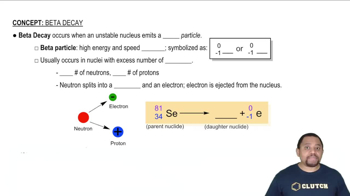This reaction was monitored as a function of time: A → B + C A plot of ln[A] versus time yields a straight line with slope -0.0105/s. a. What is the value of the rate constant (k) for this reaction at this temperature?
a. What is the half-life for the first-order decomposition of SO2Cl2 with a rate constant of 1.42 x 10^-4 s^-1? b. How long will it take for the concentration of SO2Cl2 to decrease to 25% of its initial concentration? c. If the initial concentration of SO2Cl2 is 1.00 M, how long will it take for the concentration to decrease to 0.78 M? d. If the initial concentration of SO2Cl2 is 0.150 M, what is the concentration of SO2Cl2 after 2.00 x 10^2 s? After 5.00 x 10^2 s?
 Verified step by step guidance
Verified step by step guidanceKey Concepts
First-Order Reactions

Half-Life

Exponential Decay

This reaction was monitored as a function of time: AB → A + B A plot of 1/[AB] versus time yields a straight line with a slope of +0.25/Ms. b. Write the rate law for the reaction.
Silver nitrate solutions are often used to plate silver onto other metals. What is the maximum amount of silver (in grams) that can be plated out of 4.8 L of an AgNO3 solution containing 3.4% Ag by mass? Assume that the density of the solution is 1.01 g/mL.
The decomposition of XY is second order in XY and has a rate constant of 7.02⨉10-3 M-1• s-1 at a certain temperature. a. What is the half-life for this reaction at an initial concentration of 0.100 M?
The half-life for the radioactive decay of U-238 is 4.5 billion years and is independent of initial concentration. How long will it take for 20% of the U-238 atoms in a sample of U-238 to decay?
